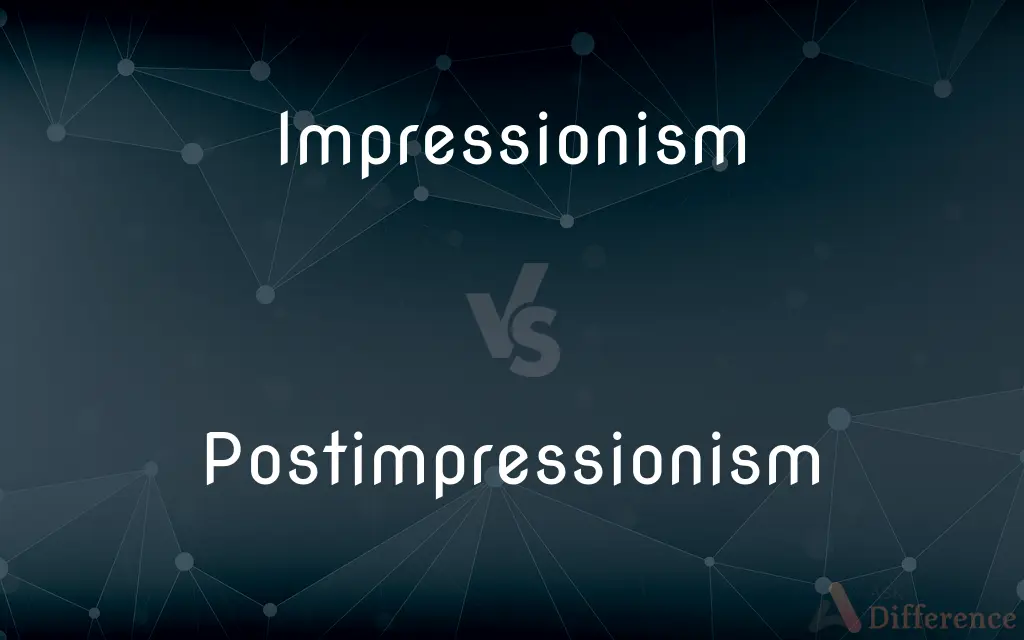Impressionism vs. Postimpressionism — What's the Difference?
By Fiza Rafique & Urooj Arif — Updated on May 16, 2024
Impressionism is an art movement focusing on capturing light and momentary effects using visible brushstrokes and vibrant colors, while Postimpressionism is a reaction to Impressionism, emphasizing more structured, symbolic, and expressive qualities.

Difference Between Impressionism and Postimpressionism
Table of Contents
ADVERTISEMENT
Key Differences
Impressionism emerged in the late 19th century, characterized by its focus on capturing the fleeting effects of light and color through loose brushwork and vibrant palettes. Artists like Claude Monet and Pierre-Auguste Renoir often painted outdoor scenes to depict the natural interplay of light. Postimpressionism followed in the late 19th and early 20th centuries, building on Impressionism but diverging in its approach to form and content.
Impressionism emphasized spontaneity and the visual perception of a moment, often avoiding detailed outlines and instead focusing on the overall impression. Postimpressionism, however, introduced more emphasis on geometric forms, distorted perspectives, and the artist’s emotional response, moving towards abstraction and symbolism.
While both movements broke away from the traditional academic art of their time, Impressionism maintained a lighter, more immediate feel. Postimpressionism explored new directions, leading to the development of diverse styles that influenced modern art movements such as Expressionism and Cubism.
Comparison Chart
Time Period
Late 19th century
Late 19th to early 20th century
Focus
Capturing light and momentary effects
Structure, symbolism, and emotional depth
ADVERTISEMENT
Technique
Loose brushwork, vibrant colors
Distinct brushstrokes, bold colors
Key Artists
Claude Monet, Pierre-Auguste Renoir
Vincent van Gogh, Paul Cézanne
Style
Spontaneous, visual perception
Geometric forms, emotional expression
Influence
Traditional academic art
Modern art movements like Expressionism, Cubism
Approach
Outdoor scenes, natural light
Diverse subjects, often more abstract
Compare with Definitions
Impressionism
Avoids detailed outlines, focusing instead on the overall impression.
Berthe Morisot’s works feature soft edges and a focus on light.
Postimpressionism
Characterized by distinct brushstrokes and bold color use.
Paul Cézanne’s Mont Sainte-Victoire uses geometric shapes to structure the landscape.
Impressionism
Often depicts outdoor scenes and natural light.
Camille Pissarro’s landscapes show the changing effects of light throughout the day.
Postimpressionism
An art movement reacting to Impressionism, emphasizing structure and symbolism.
Vincent van Gogh’s Starry Night conveys emotional depth and symbolic meaning through swirling forms.
Impressionism
Characterized by loose brushwork and vibrant color palettes.
Pierre-Auguste Renoir’s Dance at Le Moulin de la Galette uses loose brushstrokes to capture a lively scene.
Postimpressionism
Moves towards abstraction and diverse subjects.
Georges Seurat’s pointillism in A Sunday Afternoon on the Island of La Grande Jatte explores new techniques.
Impressionism
An art movement focusing on capturing light and momentary visual effects.
Claude Monet's Impression, Sunrise exemplifies the Impressionist focus on light and atmosphere.
Postimpressionism
Paves the way for modern art movements like Expressionism and Cubism.
Paul Gauguin’s use of color and form influenced later abstract artists.
Impressionism
Emphasizes spontaneity and the artist’s immediate visual perception.
Edgar Degas often captured fleeting moments of ballet dancers in motion.
Postimpressionism
Focuses on the artist’s emotional response and individual vision.
Henri Rousseau’s The Sleeping Gypsy incorporates dream-like symbolism.
Impressionism
Impressionism is a 19th-century art movement characterized by relatively small, thin, yet visible brush strokes, open composition, emphasis on accurate depiction of light in its changing qualities (often accentuating the effects of the passage of time), ordinary subject matter, inclusion of movement as a crucial element of human perception and experience, and unusual visual angles. Impressionism originated with a group of Paris-based artists whose independent exhibitions brought them to prominence during the 1870s and 1880s.
Postimpressionism
A school of painting in France in the late 1800s that rejected the objective naturalism of impressionism and used form and color in more personally expressive ways.
Impressionism
Often Impressionism A theory or style of painting originating and developed in France during the 1870s, characterized by concentration on the immediate visual impression produced by a scene and by the use of unmixed primary colors and small strokes to simulate actual reflected light.
Postimpressionism
(arts) A genre of painting that rejected the naturalism of impressionism, using colour and form in more expressive manners.
Impressionism
A literary style characterized by the use of details and mental associations to evoke subjective and sensory impressions rather than the re-creation of objective reality.
Impressionism
(Music) A style of art music of the late 1800s and early 1900s, often evoking a dreamy mood and characterized by modal or whole-tone scales, rich and often dissonant harmonies in unconventional progressions, and the avoidance of traditional forms.
Impressionism
(arts) a movement in art characterized by visible brush strokes, ordinary subject matters, and an emphasis on light and its changing qualities
Impressionism
(music genre) a style that avoided traditional harmony, and sought to invoke the impressions of the composer
Impressionism
(poetry) a style that used imagery and symbolism to portray the poet's impressions
Impressionism
The theory or method of suggesting an effect or impression without elaboration of the details; - a disignation of a recent fashion in painting and etching.
Impressionism
A school of late 19th century French painters who pictured appearances by strokes of unmixed colors to give the impression of reflected light
Common Curiosities
Who are key artists of Impressionism?
Key artists include Claude Monet, Pierre-Auguste Renoir, Edgar Degas, and Camille Pissarro.
What is Impressionism?
Impressionism is an art movement focusing on capturing light and momentary visual effects with loose brushwork and vibrant colors.
Who are key artists of Postimpressionism?
Key artists include Vincent van Gogh, Paul Cézanne, Henri Rousseau, and Georges Seurat.
How does Impressionism differ in technique?
Impressionism uses loose brushwork and focuses on light and color, often avoiding detailed outlines.
What is a famous work of Impressionism?
"Impression, Sunrise" by Claude Monet is a famous work that gave the movement its name.
What is Postimpressionism?
Postimpressionism is a movement that reacted to Impressionism, emphasizing more structure, symbolism, and emotional expression.
What is the main focus of Impressionist art?
The main focus is on capturing the fleeting effects of light and atmosphere.
How did Impressionism influence later art movements?
Impressionism broke away from academic traditions and influenced the development of modern art.
What subjects do Impressionist artists typically depict?
Impressionist artists often depict outdoor scenes, landscapes, and moments of everyday life.
What subjects do Postimpressionist artists typically depict?
Postimpressionist artists explore diverse subjects, often with more abstract and symbolic elements.
How did Postimpressionism influence later art movements?
Postimpressionism paved the way for movements like Expressionism and Cubism by exploring new forms and techniques.
What is the main focus of Postimpressionist art?
The main focus is on structure, symbolism, and conveying emotional depth.
How does Postimpressionism differ in technique?
Postimpressionism uses distinct brushstrokes, bold colors, and emphasizes geometric forms and emotional expression.
How do Impressionism and Postimpressionism view color?
Impressionism focuses on natural light and color; Postimpressionism uses color more boldly and symbolically.
What is a famous work of Postimpressionism?
"Starry Night" by Vincent van Gogh is a famous work known for its emotional and symbolic depth.
Share Your Discovery

Previous Comparison
Service vs. Hospitality
Next Comparison
Bangle vs. BraceletAuthor Spotlight
Written by
Fiza RafiqueFiza Rafique is a skilled content writer at AskDifference.com, where she meticulously refines and enhances written pieces. Drawing from her vast editorial expertise, Fiza ensures clarity, accuracy, and precision in every article. Passionate about language, she continually seeks to elevate the quality of content for readers worldwide.
Co-written by
Urooj ArifUrooj is a skilled content writer at Ask Difference, known for her exceptional ability to simplify complex topics into engaging and informative content. With a passion for research and a flair for clear, concise writing, she consistently delivers articles that resonate with our diverse audience.
















































